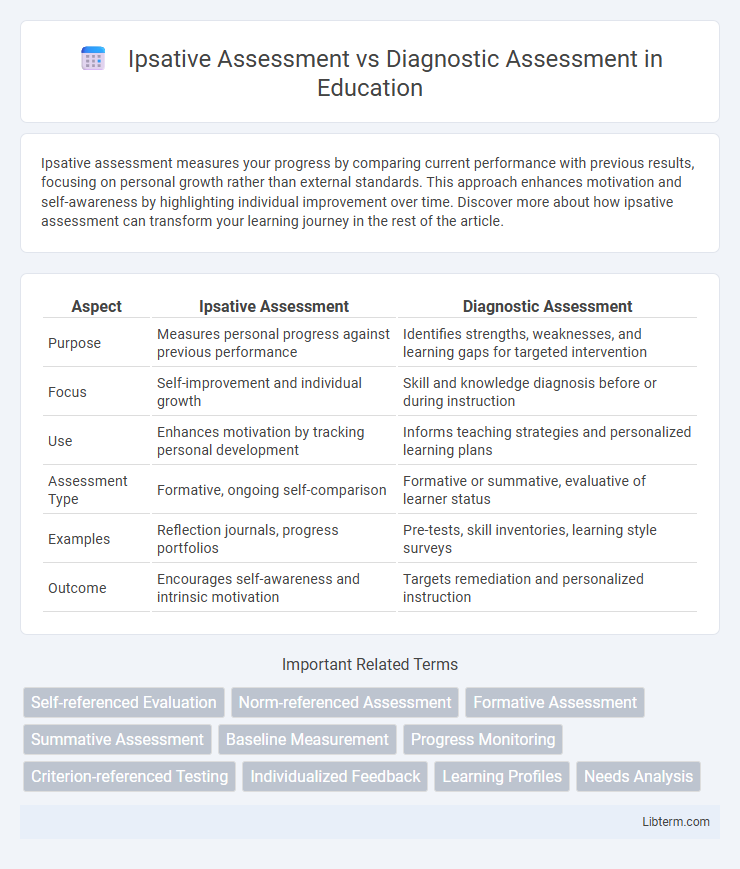Ipsative assessment measures your progress by comparing current performance with previous results, focusing on personal growth rather than external standards. This approach enhances motivation and self-awareness by highlighting individual improvement over time. Discover more about how ipsative assessment can transform your learning journey in the rest of the article.
Table of Comparison
| Aspect | Ipsative Assessment | Diagnostic Assessment |
|---|---|---|
| Purpose | Measures personal progress against previous performance | Identifies strengths, weaknesses, and learning gaps for targeted intervention |
| Focus | Self-improvement and individual growth | Skill and knowledge diagnosis before or during instruction |
| Use | Enhances motivation by tracking personal development | Informs teaching strategies and personalized learning plans |
| Assessment Type | Formative, ongoing self-comparison | Formative or summative, evaluative of learner status |
| Examples | Reflection journals, progress portfolios | Pre-tests, skill inventories, learning style surveys |
| Outcome | Encourages self-awareness and intrinsic motivation | Targets remediation and personalized instruction |
Understanding Ipsative Assessment
Ipsative assessment measures a learner's progress by comparing their current performance to their previous results, highlighting personal growth and development over time. Unlike diagnostic assessment, which identifies specific strengths and weaknesses to guide future learning needs, ipsative assessment fosters intrinsic motivation by emphasizing self-improvement and mastery. This approach is particularly effective in personalized learning environments where tracking individual progress is crucial for tailored educational strategies.
Defining Diagnostic Assessment
Diagnostic assessment identifies students' prior knowledge, skills, and learning gaps before instruction begins, enabling targeted interventions. Ipsative assessment, by contrast, compares current student performance against their previous achievements to measure individual progress over time. While diagnostic assessment informs initial teaching strategies, ipsative assessment supports ongoing personal growth monitoring.
Key Differences Between Ipsative and Diagnostic Assessments
Ipsative assessment measures a learner's performance compared to their previous results, emphasizing personal progress and self-improvement, whereas diagnostic assessment evaluates a learner's current knowledge and skills to identify strengths, weaknesses, and learning gaps. Ipsative assessments are formative, fostering motivation through self-referenced growth, while diagnostic assessments are often used before instruction to tailor teaching strategies and interventions. The key difference lies in their purpose: ipsative assessments track individual development over time, and diagnostic assessments provide a snapshot of a learner's abilities to inform targeted support.
Advantages of Ipsative Assessment
Ipsative assessment offers personalized feedback by comparing a learner's current performance against their previous achievements, promoting self-improvement and intrinsic motivation. It enables tailored learning paths by highlighting individual progress rather than comparing against external standards or peers. This assessment method fosters a growth mindset and encourages continuous development by focusing on personal goals and development over time.
Benefits of Diagnostic Assessment
Diagnostic assessment provides detailed insights into students' existing knowledge, skills, and learning gaps, enabling targeted instruction that addresses specific weaknesses effectively. This type of assessment helps educators design personalized learning plans and interventions, improving overall academic performance and reducing learning disparities. By identifying root causes of misunderstandings early, diagnostic assessment supports timely support and promotes long-term educational success.
Limitations of Ipsative and Diagnostic Assessments
Ipsative assessment is limited by its subjective comparison only to a learner's past performance, making it difficult to measure progress against external standards or peers. Diagnostic assessment often faces challenges due to its reliance on initial testing conditions, which may not capture all underlying learning difficulties or provide a comprehensive measure of student ability. Both assessments can lack objectivity and broad applicability, restricting their effectiveness in diverse educational contexts.
When to Use Ipsative vs Diagnostic Assessment
Ipsative assessment is most effective when measuring personal improvement over time, especially in settings focused on individual growth and development, such as coaching or personalized learning plans. Diagnostic assessment is best suited at the beginning of a learning process or clinical evaluation to identify specific strengths, weaknesses, and knowledge gaps, allowing for targeted interventions. Choosing ipsative assessment helps track progress against previous performances, while diagnostic assessment guides initial planning by pinpointing areas needing attention.
Impact on Student Learning Outcomes
Ipsative assessment measures a student's progress by comparing current performance with previous personal achievements, enhancing motivation and personalized learning paths which can lead to improved self-regulation and academic growth. Diagnostic assessment identifies specific strengths and weaknesses before instruction, enabling targeted interventions that address learning gaps and support more effective curriculum planning. Combining both assessments optimizes student learning outcomes by fostering individual progress monitoring alongside precise identification of instructional needs.
Best Practices for Implementing Both Assessment Types
Ipsative assessment focuses on measuring a learner's progress against their previous performances, encouraging self-reflection and personalized growth, while diagnostic assessment identifies learners' strengths and weaknesses to tailor instruction effectively. Best practices for implementing ipsative assessment include setting clear individual goals, providing consistent feedback, and fostering a growth mindset. For diagnostic assessment, it is crucial to use reliable tools, conduct assessments early in the learning process, and use insights to design targeted interventions that address specific learning gaps.
Choosing the Right Assessment for Your Educational Goals
Ipsative assessment measures a learner's progress by comparing current performance to their previous results, making it ideal for tracking personal growth and motivating individual improvement. Diagnostic assessment identifies specific strengths and weaknesses before instruction begins, allowing educators to tailor lesson plans and interventions effectively. Selecting the right assessment depends on whether the goal is to monitor personal development over time or to pinpoint learning gaps for targeted support.
Ipsative Assessment Infographic

 libterm.com
libterm.com